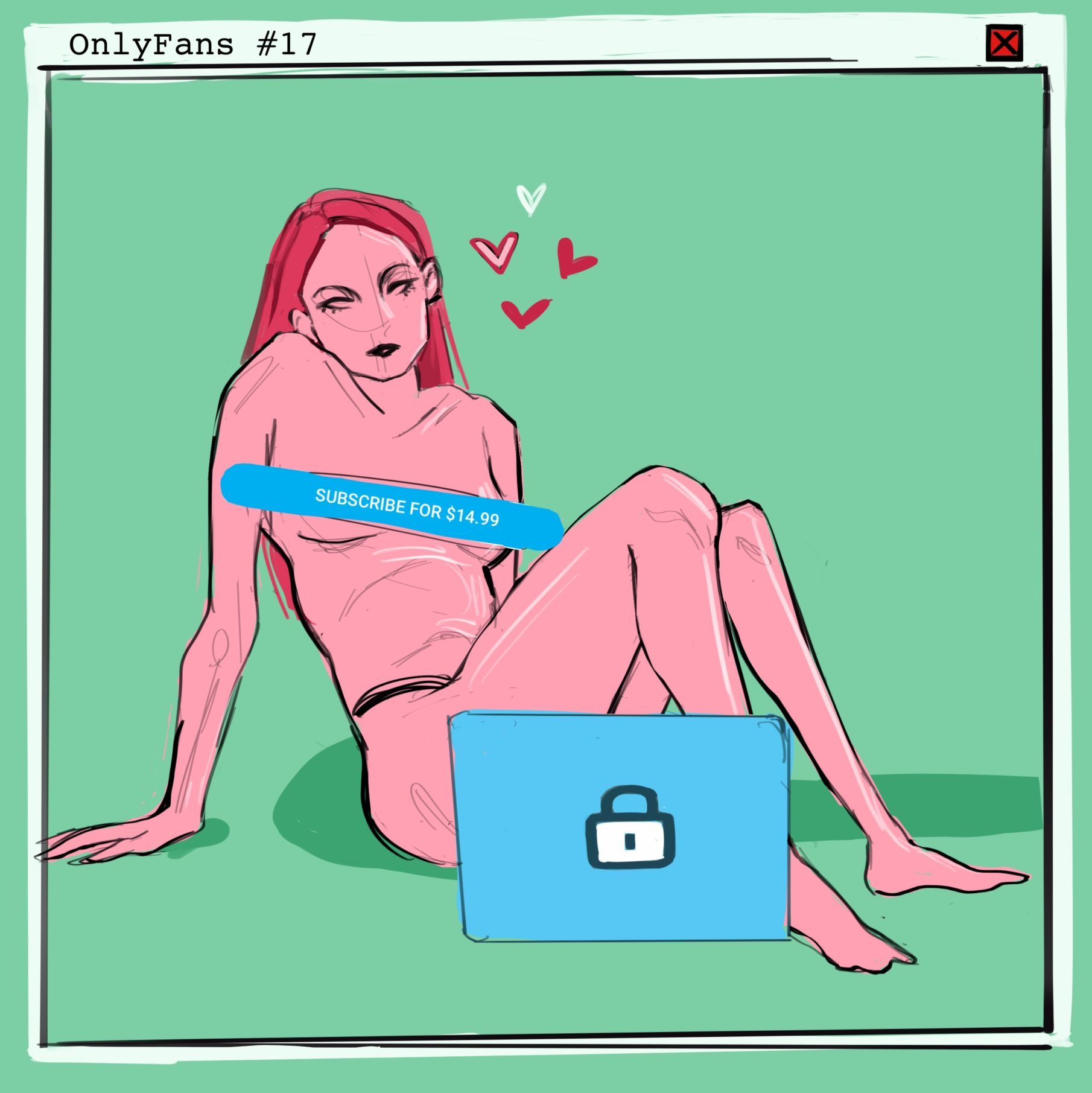[Written by Beatrice Efimov (she/her)]
[Art by Yana Dzhakupova (she/her)]
Content Warning: Discussions of sex work and pornography
Covid-19 forced the closure of businesses across the world, affecting owners, workers, and customers alike. As face to face contact ceased to be the norm, the majority of our daily activities moved online and most of us immersed ourselves into a digital reality. Online platforms such as Zoom and Houseparty acquired new-found importance in our insular lives, offering a place of solace and connection. As most of our relationships, classes, fitness activities and hobbies moved online, our sex lives followed. Digital sex work exploded overnight, and platforms such as OnlyFans, ManyVids and IsMyGirl were flooded with newcomers.
Out of all the digital sex work platforms, OnlyFans received the most notoriety, its name became part of our lockdown vocabulary. The rapid increase in signups to such sites during lockdown raised concerns about the negative impacts of an oversaturated, competitive market and the role pop culture, celebrities and influencers have played in cultivating it. As the number of high profile accounts continues to grow, many have grown concerned that this development reinforces the false narrative that sex work is easy and should be treated as casual labour.
OnlyFans was founded in 2016 and was marketed as a place where anyone with a fan base could profit from through selling exclusive content and developing a more personal relationship with their fans. For those unfamiliar, OnlyFans functions on the basis that content producers (users who share videos, pictures, etc.) charge a monthly subscription fee that can range from $5 to $50. This gives users access to the content producer’s feed of photos and videos. For additional fees, fans can receive exclusive content, make personalised requests, and be in direct contact with the content producer.
In many ways OnlyFans has helped to regenerate the profitability of the porn industry to the benefit of the performers. This is because the platform takes a 20% cut from each transaction, leaving the content producer with 80%, on top of enforcing strict rules on content piracy. This was one of the main downfalls of the porn industry where free, pirated porn results in low wages for the performers. Additionally, OnlyFans has less stringent regulations on nudity and can be marketed for free through promotion on Twitter and other social media platforms, making it more straightforward for content producers to grow their following.
The spread of Covid-19 has led to a more saturated and, by default, competitive market, which has resulted in some significant changes being made to the platform. According to Mashable, in March 2020 OnlyFans had 26 million registered users, 350 thousand of whom were content creators. By August 2020, the platform had 50 million registered users, 750 thousand of whom were content creators. Moreover, Forbes stated that in April 2020, OnlyFans was receiving 150 thousand new signups every 24 hours.
In order to compete with this surge in users, content producers have had to improve their marketing game to stand out; relentlessly generating content to keep customers satisfied and, in some cases, lowering their subscription prices to gain fans and undercut competitors. To make matters worse, in May 2020, Onlyfans cut the lucrative, lifetime referral policy to only one year. This means that content producers who would have previously received a 5% lifetime commission on the earnings of content producers that they had introduced to the platform, via their referral code, now only get 12 months of commission. The lifetime referral policy was introduced in order to motivate content producers to encourage new signups, which the platform no longer saw as a priority once its user base multiplied so rapidly.
As mentioned previously, the influx of celebrities and influencers on the platform has reinforced the false narrative regarding the nature of sex work. One influencer Caroline Calloway boasted about her projected six figure annual salary to her 57 thousand followers on Twitter, while Bella
Thorne made headline news for raking in $2 million in her first week on the platform. Shortly after Thorne’s short stint in August, three serious changes occurred to the platform: the introduction of cap on payments for photos to $50 per view (previously $200), the limitation of tips to $100, and the instatement of a hold on the processing of payments.
It is clear that influencers and celebrities are directly profiting from their already built up, loyal fan base, without acknowledging the privilege they hold compared to other content producers who require OnlyFans as a source of income. Little attempt is made on their part to support the
sex work community: there is no collaboration with content producers to direct their fans to other accounts, or promotion of educational materials about the importance of sex workers’ rights and the discrimination and hardships they face due to stigma. Influencers and celebrities, such as Calloway and Thorne, do not acknowledge that content producers are in full time jobs and running businesses – constantly planning shoots, messaging fans, editing their work, and marketing themselves in an increasingly competitive market.
OnlyFans has opened up conversations surrounding sex work; however, it seems that the platform’s popularity might play out to the detriment of sex workers. Just like with Tumblr and Instagram, digital sex workers could find themselves kicked off the platform, substituted by celebrities and influencers who have moved in and capitalised on their space. It appears that, once again, market logic has created winners and losers, further damaging an already stigmatised community.

